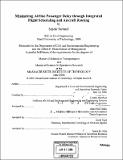| dc.contributor.advisor | Cynthia Barnhart and John-Paul Clarke. | en_US |
| dc.contributor.author | Sarmadi, Sepehr, 1977- | en_US |
| dc.contributor.other | Massachusetts Institute of Technology. Operations Research Center. | en_US |
| dc.date.accessioned | 2005-10-14T20:20:52Z | |
| dc.date.available | 2005-10-14T20:20:52Z | |
| dc.date.copyright | 2004 | en_US |
| dc.date.issued | 2004 | en_US |
| dc.identifier.uri | http://hdl.handle.net/1721.1/29401 | |
| dc.description | Thesis (S.M.)--Massachusetts Institute of Technology, Dept. of Civil and Environmental Engineering; and, (S.M.)--Massachusetts Institute of Technology. Operations Research Center, 2004. | en_US |
| dc.description | Includes bibliographical references (p. 83-86). | en_US |
| dc.description.abstract | Statistics show that airline flight delays and cancellations have increased continuously over the period from 1995 to 2000. During the same period, customer dissatisfaction and complaints have followed a similar, even more dramatic trend. In 2001, as a consequence of the September 1 th terrorist attacks and the resulting airline schedule reductions, delay levels decreased, but only temporarily. With growing passenger demands and stagnant capacity passenger delays and disruptions are again on the rise. Approaches to mitigate schedule disruptions include: 1) re-optimizing the schedule during operations after a disruption occurs. For example, an airline operations controller might decide to cancel or postpone some flight legs or to re-route some aircraft to recover the rest of the schedule; and 2) building robustness into the schedule in the planning stage. By robustness we mean the ability to absorb flight delays so these effects are minimized on passengers and crews. In many cases, trying to reduce delays in the planning stage can be less costly for the airlines, especially if the actions suggested to modify the schedule are not expensive. Pushing back a flight's departure time only ten minutes might cost the airline little but can potentially reduce the number of passenger misconnections given the stochastic nature of airline operations. Canceling a flight during operations for example, can be however very costly. The primary goal of this research is to propose planning models to re-route aircraft and re-time flight departures, either separately or simultaneously, in order to distribute slack time in the network optimally and reduce passenger delays. Using data from a major U.S. airline we observe that with our model, we can reduce flight and passenger delay levels. | en_US |
| dc.description.statementofresponsibility | by Sepehr Sarmadi. | en_US |
| dc.format.extent | 89 p. | en_US |
| dc.format.extent | 3009465 bytes | |
| dc.format.extent | 3009274 bytes | |
| dc.format.mimetype | application/pdf | |
| dc.format.mimetype | application/pdf | |
| dc.language.iso | eng | en_US |
| dc.publisher | Massachusetts Institute of Technology | en_US |
| dc.rights | M.I.T. theses are protected by copyright. They may be viewed from this source for any purpose, but reproduction or distribution in any format is prohibited without written permission. See provided URL for inquiries about permission. | en_US |
| dc.rights.uri | http://dspace.mit.edu/handle/1721.1/7582 | |
| dc.subject | Civil and Environmental Engineering. | en_US |
| dc.subject | Operations Research Center. | en_US |
| dc.title | Minimizing airline passenger delay through integrated flight scheduling and aircraft routing | en_US |
| dc.type | Thesis | en_US |
| dc.description.degree | S.M. | en_US |
| dc.contributor.department | Massachusetts Institute of Technology. Department of Civil and Environmental Engineering | en_US |
| dc.contributor.department | Massachusetts Institute of Technology. Operations Research Center | en_US |
| dc.identifier.oclc | 56132667 | en_US |
